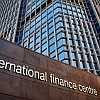Wed, September 23rd 2009, 11:18PM:
The colours are all there... -- OR -- Why shooting RAW pays...
Even after years of digital image editing I, sometimes, still are surprised to discover what colours may be hidden in images, that appear dull at a first glance. In case of this image, I was truely lucky that my 30D perfectly exposed the shot "to the right" without blowing the highlights in the sky. As a result, the sky contained incredibly fine graduations of blueish and redish tones, since clouds were lit by the setting sun beneath a crystal blue sky.
These colours, however, were not visible initially, since all (12 bit) R, G and B channel values were close to saturation: As they were showing values above 1024, they were mapped to more or less the same tonal range (about 232 up to 255) while applying the usual gamma correction and converting the linear sensor data to an 8 bit output. By skipping those in-camera processings and stretching the curves even a little more, I was able to find a better mapping of the initial highlight range (1024 - 4095) to my 8 bit working space and, thus, retrieve all those colours from the sky.
So why does shooting RAW help here? Imagine I would have taken my "out of the camera" JPEG file, which already would have contained the camera's gamma correction and sensor data conversions. In order to retrieve the sky's details and get those punchy colours and contrasts, I would have had to stretch the JPEG's tonal highlight range (232 - 255, i.e. 23 values) to, let's say, 64 - 255. The result would have been heavy posterization and a highly noisy sky. Using the RAW data, however, I had a much larger tonal range (1024 - 4095, i.e. 3071 values) to be mapped to 64 - 255: No posterization, but a smooth, clean sky instead!

|